Updating the post The "soft side" of commercial district revitalization
This post was originally published on April 24th, 2006. I CAN'T BELIEVE I NEGLECTED TO INCLUDE PUBLIC SAFETY AS AN ELEMENT TO ADDRESS. (It was assumed and I think it's present indirectly in the list, but it needs to be called out.)
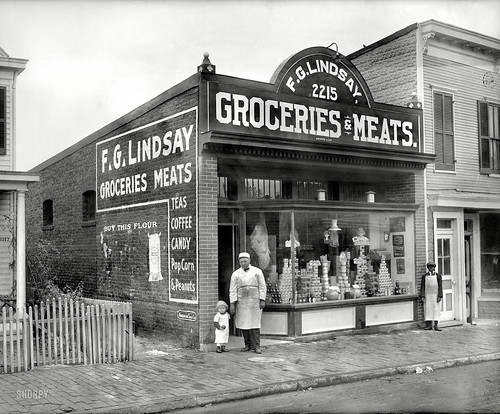 Visual merchandising back in the day. F.G. Lindsay store front, Anacostia, 2215 Nichols Avenue. National Photo Company, LC.
Visual merchandising back in the day. F.G. Lindsay store front, Anacostia, 2215 Nichols Avenue. National Photo Company, LC.Not that people read the backfile of this blog, although they should. Someone recounted a conversation they had with a DC boutique owner operating a retail business in a transitioning commercial district which touched on many of the issues that I wrote about in the piece below.
They discussed the issue of vagrancy and loitering in a commercial district and street corridors, litter, dealing with "legacy" store owners who are car-centric but also will sell what they can sell in order to make money and this can be counter-productive (e.g., "Authorities close store in Southeast D.C. for selling synthetic drugs," Washington Post), how business owners are unaccustomed to thinking in terms of a commercial district as a whole rather than their own business, they aren't interested in coming to meetings and organizing and contributing to necessary change, etc.
(It reminded me that while I like to do commercial district revitalization planning, it is usually no fun working with legacy merchants and property owners.)
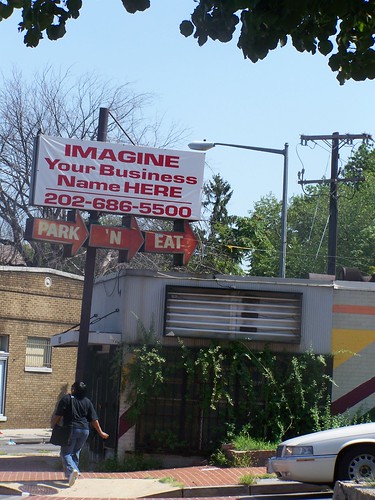 This comes up in the Eastern Market district, where people are organizing a "Main Street" commercial district revitalization effort even though the area is a couple blocks from a Main Street program on 8th Street SE called Barracks Row.
This comes up in the Eastern Market district, where people are organizing a "Main Street" commercial district revitalization effort even though the area is a couple blocks from a Main Street program on 8th Street SE called Barracks Row.It'd be easier to imagine my business at this location if the property was maintained....
It reaffirms my belief that DC needs a much more nuanced approach to promoting and developing the city's various commercial districts, one element as I said in the previous entry on World Tourism Day, has to do with providing marketing and other support to those areas that have the potential to serve segments of the tourism market. Main Street is the one size fits all approach pushed forward by the city, but it's not the right model in many places.
Furthermore, it's very weak on support and development of new retail business concepts, and local governments need different methods. In fact, I've been thinking about this too, in terms of posts I had written about ten years ago on the Historic Downtown Los Angeles Retail Project--now defunct--which was specifically created to foster the development of retail businesses in Downtown LA, which at the time had many vacant properties and underrepresented retail categories.
A more current example is the Vital'Quartier initiative in Paris where the SEMAEST community development corporation has been charged by the city to buy and hold real estate and rent it to desired retailers at sub-market prices. According to Next Paris ("Opération Vital'Quartier: pour le commerce de proximité à Paris!") so far the initiative has supported 372 businesses in more than 500,000 s.f. of space.
==========
Late Friday, I wrote some email on the Main Street list in response to a query about cleaning services in neighborhood commercial districts. The following is a cobbling together of three emails...
When is the last time you went to a dirty, filthy shopping mall? Why do Main Street merchants believe that the expectations of the customers are any different when they are considering shopping in neighborhood or downtown commercial districts?
I am a firm believer in Donald Shoup's (professor at UCLA) statement that public help should go to those who've already begun helping themselves. I know that Main Street merchants aren't the ones dirtying their street, but why are they so cavalier about the impact of unkempt sidewalks upon their ability to attract customers?
I do understand why merchants think that way--they are not the ones dirtying the streets. The disconnect concerns the perceptions that customers and potential customers have about the commercial district and the businesses located there, as well as the condition of the area around the business. People dirty the streets around the merchants' businesses, and if the problems aren't corrected, other people's carelessness costs the merchants money...
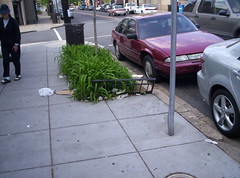
3500 block west side, 12th Street NE, Brookland. Recognize that I already had picked up a fair amount of trash from this sidewalk on my way to the drug store, before I came back with my camera.
Right now, people in the neighborhood are talking about this particular restaurant and how great the new owner is, etc., but that ignores the condition of the exterior of the building.

Ohio Restaurant, 1300 block H Street NE, Washington, DC. Photo by Elise Bernard. For various reasons, this property has been vacant for about 10 years.
Few people are going to patronize the business except as a reflection of "community support" or having no other options. (The issue is to work to get the facade improved... not to discourage the business from improving, but in the current condition this business is unlikely to generate "catalytic" improvement benefits that contribute to the commercial district as a whole.)
One of the theories of commercial district development is called the Reilly Law of Retail Gravitation. The way I describe it is thusly: people choose to shop in the commercial district that has more and better stores that is also (more) convenient to get to.
But the Reilly Law is more than just the number of type of stores. This is why I talk about "soft aspects" in relation to it, in terms of external and "internal" factors. External factors concern the commercial district as a whole. Internal factors the store. I wrote a more expansive piece on this topic in September 2007 ("Analyzing retail store failure," although the post was originally titled, "Why ask why? Because").
External
(1) the quality and condition of the buildings;
(2) the cleanliness of the street and sidewalks in the district;
(3) public safety in the commercial district*
(4) transportation convenience (walking, biking, and transit as well as driving; this is captured by the Reilly equations, but is worth calling out, yes this includes parking but doesn't mean providing scads of it as much as it means addressing the issue, including parking wayfinding, also see "Parking districts vs. transportation/urban management districts: Part two, Takoma DC/Takoma Park Maryland" from 2015)*
(5) the condition of the street furniture, treeboxes, roadways and other aspects of the physical environment;
Old Takoma business district map
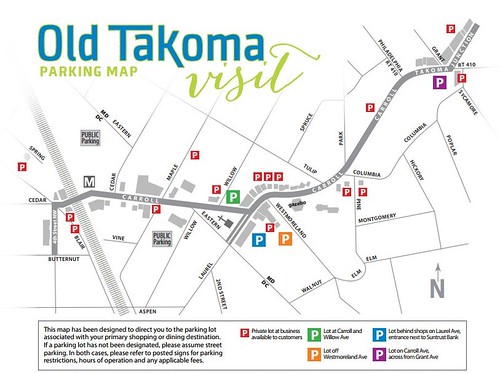
Internal
(6) the signage and windows of the businesses (this also has external characteristics);
(7) the quality and organization of the store interiors.
* added to the original list
Each influences whether or not people will choose to shop in your commercial district, or if they will merely continue to shop elsewhere because you provide no compelling reason for them to change their minds, attitudes, habits, and comfortability.

Treebox, Brookland commercial district.
These factors plus the number and quality of stores and the issue of how to get there are the primary considerations influencing people's decisions about where to shop, eat, or play...
People compare our neighborhood and downtown commercial districts to shopping centers or to the best-in-class traditional commercial districts in your region. So to be equally competitive, we have to do many of the same things the shopping centers do, and primary is providing a clean environment.
In the DC region, the best-in-class independent commercial district is Georgetown. Where do you think people would rather shop?
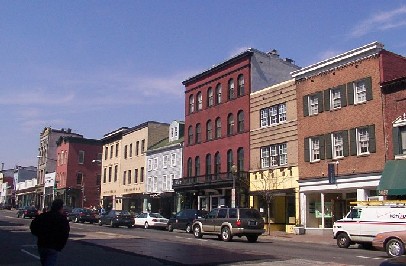
In Georgetown. Photo (resized), by Dan Malouff.
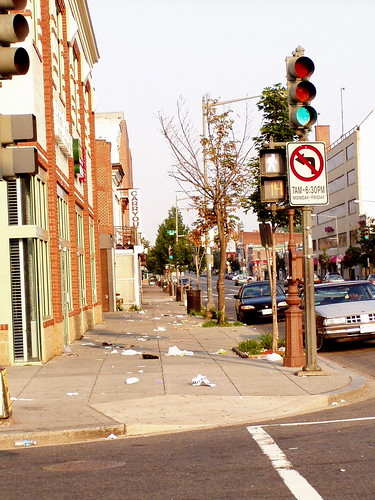
or on H Street NE? (Photo by Elise Bernard) Note that things have changed some in the 10 years since this post was written.
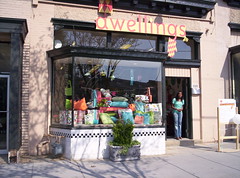
Dwellings, Brookland Commercial District, 12th Street NE (defunct--it was a nice store but at the time needed to be located in a commercial district with more foot traffic).
I think Brookland has potential, but it needs more businesses that look like this--bright, cheery, with quality and interesting products, helpful staff, and a building in good condition. Fortunately, it has many business proprietors who do understand the direction that the commercial district needs to move toward.
On Saturday, It occurred to me that the best way that Brookland can make a case for commercial district cleaning services is to do a litter survey at different times of the day, to begin to develop a priority list and a strong case for funding additional services:
-- identify which areas are consistently dirty;
-- which areas need regular cleaning but less often
-- we can do X with such and such amount
-- and X + Y with additional resources
etc. This data can be used with merchants, as well as perhaps creating a kind of "Visual Preference Survey" showing them other commercial districts that their customers might patronize. And how they compare.
This is why I joke about Main Street principles #9 and #10 (there are officially only 8 principles)--knowing what you have (or not) and being honest about it; and making the hard choices you need to make in order to improve.
As long as a particular urban commercial district is deficient compared to nearby shopping alternatives, it won't be able to attract new customers, until it starts providing some decent options. You can put any kind of sugar coating on it that you want, but it's those seven factors that must be addressed.
Until you do so, your commercial district will languish because as long as your commercial district suffers on perception indicators, you will continue to have difficulties filling your vacancies and attracting higher quality and a greater variety of businesses.
Labels: commercial district revitalization planning, retail entrepreneurship development, retail planning




0 Comments:
Post a Comment
<< Home